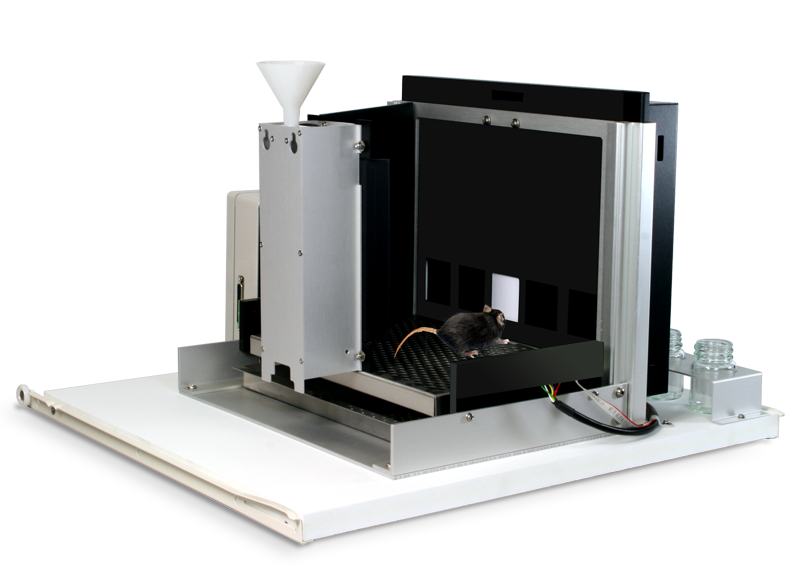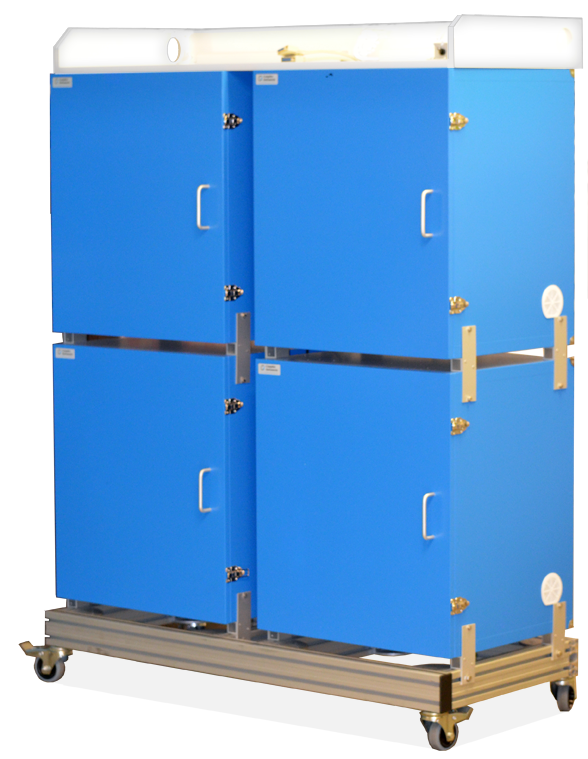
Welcome FENS Attendees
THANKS FOR STOPPING BY

THANKS FOR STOPPING BY

The Bussey-Saksida Rodent Touch Screen Chamber is the evolution of the operant chamber. Our chambers are designed for the efficient and high-throughput cognitive evaluation of rodents. For these systems, we offer many standard paradigms, prewritten to include the entire battery of tasks necessary to habituate, shape, and bring the animal to criteria on that particular application, as well as collect and analyze prepared Data Analysis Sets.
All Bussey-Saksida Touch Screen hardware conforms to a single technical standard. This standard defines all aspects of animal interactions. Due to the complexity of touch screen system hardware, electronics, and software this standard ensures conformity. Comparisons are valid and simple to carry out.
ABET Cognition software allows usage of standard, original, and customized paradigms. Standard Task Paradigms are available by arrangement with the University of Cambridge. Standard tasks include popular tasks such as PD, PAL, 5CSRT, Location Discrimination, and many more. All paradigms include training routines as well as the main experimental paradigm and the data analysis sets. Full descriptions of our standard paradigms are available upon request or by visiting our website.

| NHP/Human CANTAB Equivalent |
Standard Tasks | Typical time to reach baseline (post-pretraining) RATS | Typical time to reach baseline (post-pretraining) MICE* | Example neural systems involved | Clinical area showing impairment |
|---|---|---|---|---|---|
| NHP | Pretraining to touch an image and initiate a trial (PD, PAL, LD, VMCL & TUNL) | 1-2 weeks | 1-2 weeks (e.g., 7-8 week old C57BL6J mice: 5 days) | ||
| Human/NHP | Pairwise / Visual Discrimination (PD) | 5-7 days | 5-7 days for young mice | Prefrontal Cortex, Perirhinal Cortex, Striatum, Dopamine system, Cholinergic system, NMDA receptors | Huntington's, Schizophrenia, Parkinson's |
| Human/NHP | Paired Associate Learning (PAL) | 35-45 sessions to 80% | 35-45 sessions to 70% | Hippocampus, Cholinergic system, NMDA Receptors, AMPA Receptors | Alzheimer's, Schizophrenia |
| NHP | Visuomotor Conditional Learning (VMCL) | Approximately 20 sessions | Approximately 20 sessions | Dorsal Striatum, Posterior Cingulate Cortex | Huntington's, Parkinson's |
| NHP | Location Discrimination Learning (LDL) | 2-4 weeks | 2-4 weeks | Hippocampus, Neurogenesis | Alzheimer's, Schizophrenia, Depression |
| Human/NHP | Trial-Unique Nonmatching-to-Location (TUNL) | Approximately 4 weeks | 6-24 Sessions to acquire the basic task | Hippocampus, Cholinergic system, NMDA Receptors | Alzheimer's |
| Human/NHP | 5 Choice Serial Reaction Time (5CSRT) | 30 sessions | Pretraining (ave 10 days) + 3 weeks to 80% @ 2 sec baseline | Prefrontal Cortex, Basal Forebrain, Cholinergic (Accuracy), Serotonin (Impulsivity), Noradrenaline (Distraction), Dopamine (Motivation) | Alzheimer's, Depression, Huntington's, Schizophrenia, ADHD, OCD |
| Autoshaping (AUTO) | Several sessions | Several sessions | Ventral Striatum, Amygdala, Anterior Cingulate Cortex | Huntington's | |
| NHP | Extinction (EXT) | Approximately 4 days training + a few days extinction | Approximately 4 days training + a few days extinction | ADHD, OCD | |
| 5-Choice Continuous Performance Task (5C-CPT)** | Approximately 24 weeks (based on training in 5-hole box) | Approximately 13 weeks (based on training in 5-hole box) after training to 5-CSRTT | Dopamine, Serotonin, Colinergic, Parietal, Muscarinic. | Schizophrenia, ADHD, OCD, Alzheimer's | |
| Human/NHP | Rodent Continuous Performance Task (rCPT) | Approximately 20 days | Approximately 35 sessions | Dopamine, Serotonin, Colinergic, Parietal, Muscarinic | Schizophrenia, ADHD, OCD, Alzheimer’s |
| Human | 4-Choice Gambling Task (4C-GT)*** | Approximately 20 sessions (based on training in 5-hole box) | Training times to be confirmed | Dopamine, Serotonin | Bipolar Disorder, Gambling |
| NHP | Progressive Ratio (PR) Task | Results for rats not yet available | 16 days from first habituation to reach stable PR performance | Dopamine | Motivation |
* Depends on strain and age
** Young et al, The 5-Choice Continuous Performance Test: Evidence for a Translational Test of Vigilance for Mice. Plosone, January 19, 2009 DOI: 10.1371/journal.pone.0004227 Barnes et al. D1 receptor activation improves vigilance in rats as measured by the 5-choice continuous performance test. Psychopharmacology (Berl). 2012 Mar;220(1):129-41
*** Zeeb et al. Sertonergic and Dopamine Modulation of Gambling Behaviour as Assessed Using a Novel Rat Gambling Task. Neuropsychopharmacolgy 2009 34,2329 van Enkhuizen et al. Differential effects of dopamine transporter inhibitors in the rodent Iowa Gambling Task: Relevance to mania. Psychopharmacology (Berl). Feb 2013; 225(3): 661–674
Full Paradigm Task Reference and Bibliography is available by visiting our website

The Easy-Install keeps your lab organized by hiding the many cables in trunking and the whole system easily moveable for cleaning. Designed as a factory built, pre-cabled system that can be taken from a transit crate in one piece and wheeled into place, the Easy- Install eliminates the effort needed to handle, move, and install individual stations and their connections to the system interface and control. Computer and Interface connections are easily made as all cables are routed to the PC location, above the cubicles. The user's monitor, keyboard and mouse can be located away from the system as needed.
Our Isolation Chambers were designed in consultation with the Institute of Sound and Vibration at the University of Derby England to provide a controlled environment for sound, light, and electromagnetic interference. Ergonomically designed for ease of animal handling and welfare with a ventilation fan and optional rolling shelf, these chambers can be configured with a house light, speaker, and camera observation/recording system that uses visual or IR illumination. Audible transmission measurements were performed on sound pressure z-scale. Attenuation level ensures that sound between chambers is attenuated to around 35 DB which approximates to the background noise in a quiet room.
Isolation Chambers are optionally available with built-in electromagnetic compatibility, to ensure artifact free in-vivo recording. Potential artifacts are eliminated at the source by shielding against electromagnetic output or by reducing the emissions at the component level on the printed circuit board. This is achieved by superior electronic engineering design and testing with a spectrum analyzer. Other Features include:
If you have any questions be sure to contact us
LAFAYETTE INSTRUMENT COMPANY
Worldwide
sales@lafayetteinstrument.com
Phone: (765) 423-1505
https://lafayetteneuroscience.com
CAMPDEN INSTRUMENTS
European Division
uksales@campdeninstruments.com
Phone: +44 1509 814790
https://campdeninstruments.com